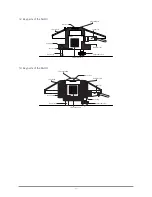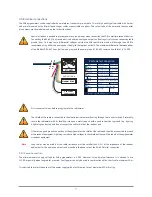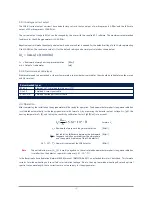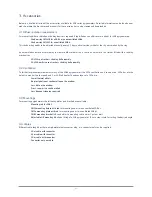
Upward long-wave radiation
Mounting plate
R
S
h
d
lower screen
always point the cables
to the nearest pole
pyrgeometer
Mast
The mounting device should not interfere significantly with the field
of view of the instrument. The upper plate prevents excessive heating
of the pyrgeometer body by solar radiation and, if large enough, it
keeps the lower screen free of precipitation. The lower glare screen
prevents direct illumination of the window by the sun at sunrise and
sunset and is available as an accessory kit for the SGR series.
The mast shown intercepts a fraction D/2πS of the radiation coming
from the ground. In the most unfavourable situation (sun at zenith)
the pyrgeometer shadow decreases the signal by a factor R²/H².
A rule of thumb is:A black shadow with radius = 0.1 H on the field
below decreases the signal by 1% and 99% of the signal will
originate from an area with radius 10 H.
Step 5. Secure pyrgeometer
Secure the pyrgeometer tightly with the two stainless steel bolts. The two nylon washers prevent contact corrosion. Ensure that
the pyrgeometer maintains the correct levelled position!
Step 6. Fit cable and sun shield
Locate the cable plug correctly in the radiometer socket (it only fits one way) and screw the plug locking ring hand-tight. Finally,
clip on the sun shield to prevent excessive heating of the radiometer body. The bubble level is visible through the top of the
pyrgeometer sun shield for routine checks.
2.2.2 Installation for measurement of radiation on inclined surfaces
It is advised to pre-adjust the levelling screws on a horizontal surface for easy orientation of the instrument parallel to the inclined
surface. Because the temperature of the mounting stand is expected to rise considerably (more than 10°C above air temperature),
the housing must be thermally isolated by the levelling screws from the stand. This will promote a thermal equilibrium between
the window and the housing and decrease zero offset signals.
2.2.3 Installation for measurement of upward long-wave radiation
In the inverted position the pyrgeometer measures radiation from the ground. According to the WMO the height should be 1 to 2 m
above a uniform surface covered by short grass.
2.2.4 Installation for shaded measurement of downward long-wave radiation
For measuring atmospheric radiation with SGR pyrgeometers it is desirable to shield the instrument from the direct short-wave
solar radiation which may heat up the pyrgeometer window and cause significant thermal offsets. The direct solar radiation is
intercepted by a small disk or sphere. The shadow of the disk must cover the pyrgeometer window completely. However, to follow
the sun's apparent motion, a power-driven tracking device is necessary.
This can be done using a Kipp & Zonen sun tracker, such as the model SOLYS2, designed to track the sun accurately under all
weather conditions. More information about the combination of pyrgeometer and tracker is given in the sun tracker manual.
Alternatively, a static shadow ring can be used to intercept the direct solar radiation; but it is less accurate and may require periodic
manual adjustment. At times the shadow ring also intercepts a proportion of the diffuse sky radiation. Therefore, corrections for this
to the recorded data are necessary.
13




























